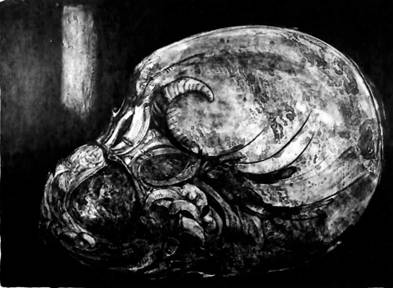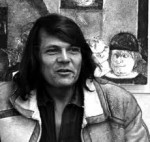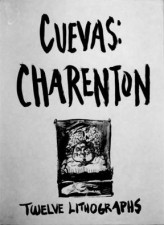
José Luis Cuevas
Mexican, 1933-
Pozo de gusanos (Worm Pit), “Cuevas-Charenton” series, 1965
lithograph
22 1/4 x 30 in.
SBMA, Gift of Bernard and Sheila Warner in memory of their son, Daniel Warner
1987.39.1.4

Photo of a young Cuervas
Within the history of Mexican art, José Luis Cuevas stands as the most prominent figure of the Ruptura (Rupture) generation—a group of young artists who rebelled against the academic mode of social realist painting in Mexico in the 1950s. In 1956, Cuevas published his best-known article, “The Cactus Curtain.” Extremely controversial at the time of its original publication in the cultural supplement of Mexico City’s Novedades newspaper, the article served as a rallying call to young artists frustrated with nationalistic art. In it he declared, “What I want in my country’s art are broad highways leading out to the rest of the world, rather than narrow trails that connect one adobe village with another.” His statements were a direct response to the Muralists’ dogmatic defenses of their art and political views—in particular, David Alfaro Siqueiros’s historic 1944 statement, “No hay más ruta que la nuestra” (“There is no other route but ours.”)

Artist: Cuevas, Jose Luis, Title: Worm Pit (Charenton XIV), Year: 1965, Tamarind Number: 1608, Nationality: Mexican, Medium: lithography, printmaking, Dimensions: 57.2 x 77.5 cm, Edition Size/Proofs: Edition of 20, BAT, 9 TI (wN), 3 AP (wN), 4 TP ((wA, 2 dLN) 1 TP (dLN) pulled for apper testing, retained by Tamrind), PTP ((AEP) Unsigned, undesignated, unchopped, retained by Tamarind), CP (Tcs), Paper Type: white Arches Printing Sequence: [1] green-black [2] black, Collaborating/Edition Printer: Smith, Clifford, Publisher: Tamarind Institute, University of New Mexico
COMMENTS
José Luis Cuevas is one of Mexico's most controversial artists of recent times, both for their behavior and for its extensive collection of works.
Born in 1934 in Mexico City, from 10 years attended as "irregular student" at the National School of Painting and Sculpture La Esmeralda and later studied graphic arts at the University Teaching Institution.
Although he has said that he mounted his first exhibition when he was only 14 years, it happened "unnoticed", Cuevas is one of the most extroverted of the breakaway generation, gaining notoriety through that participated in 1953 in his first official exhibition in Gallery Prisse, Mexico City.
This was what allowed him to meet and join a group of young artists, among them Alberto Gironella, Enrique Echeverria, Pedro Coronel, Manuel and Francisco Icaza Felguérez.
In 1959 a group of articles published in the Sunday "Mexico in Culture", the Daily News, which discloses the aesthetic ideology, based on freedom of expression, both formally and thematically, in which youth shelter painters like him.
These creators who wanted to get away from the so-called Mexican School of Painting, particularly the mural and what they considered anachronistic message of political and social content.
His nonconformist stance culminated in the development of an ephemeral mural, contradictory term with which satirizes the pretensions of continuity of that movement, which drew the attention of the national and foreign press ..
At its inception, the trend reflected Cuevas expressionism influenced by the Mexican painter Jose Clemente Orozco and gestural ferocity, say connoisseurs, statuary reminds Hispanic, particularly Mexican.
By the 60's emerged as one of the most prestigious contemporary lithographers, thanks to the series made in the U.S.: "Recollections of Childhood" (1962), "Cuevas Charenton" (1964), "Crime by Cuevas" (1968 ) and "Homage to Quevedo" (1969).
The literature has permeated his work since he illustrated "The worlds of Kafka and Cuevas" (1957), considered luxury book a valuable contribution to contemporary bibliophile.
The painter, one of the greatest representatives of neofigurativismo, is also part of the current interior, in favor of an art more inclined toward existential problems, with a view neohumanist.
For the 70 consolidates its presence as one of the most original and controversial personalities of contemporary Mexican culture, but is autoexilia feel misunderstood in France, where he reaffirms his prestige.
From his time in Europe are their "suites" graphic "Catalana" (1981), "Basque", also called "Intolerance (1983) and" Madrid "(1987), which boasts the grotesque, dark and grotesque so characteristic of the Spanish tradition.
In the 90 sculptural increased activity of various sizes, of which the most "La Giganta" (1991), a spectacular piece that exemplifies the masculine-feminine duality, it did for the courtyard of the Museo Jose Luis Cuevas, opened the following year .
It also takes the Spanish influence in developing his "Andalusian Suite" (1993), made during a stay of several months in Seville, a city next to Paris and Merida, Yucatan, the birthplace of his mother, are his favorites.
Proud that in a sample endorsed by the Spanish artist Pablo Picasso, creator of Cubism, bought two of her works, Cuevas has mounted exhibitions percent in major cities worldwide.
He has received major awards and accolades including First Prize in the International Drawing Biennial V Sao Paulo (1959), the National Prize of Sciences and Arts of Mexico (1981) and "Francisco Prieto" in Spain (1997).
Among other major awards he has received include the Order of Knight of Arts and Letters of the French Republic (1991) and entered in the National System of Creators, of Mexico, as Creator Emeritus (1993), is also invested Doctor Honoris Cause by several universities in Latin America, among many other awards.
With the death of his wife Bertha, who was director of the Museo Jose Luis Cuevas, 1994 to May 2000, ending the practice of photographic portrait she took daily since 1955, when they met, until a few months before his death.
José Luis Cuevas married three years ago with fellow artist Beatriz del Carmen Bazán, who according to the creator, she said the color returned to his work and his life.
http://translate.google.com/translate?hl=en&sl=es&u=http://books.google.com/books/about/Cuevas.html%3Fid%3DmGc7HQAACAAJ&prev=/search%3Fq%3DJose%2BCuevas%2Bcharenton%2Bseries%26hl%3Den%26client%3Dsafari%26tbo%3Dd%26rls%3Den&sa=X&ei=SvQFUfPgHMqY2AWuvoG4AQ&ved=0CD0Q7gEwAg
SBMA CURATORIAL LABELS
José Luis Cuevas produced the “Cuevas-Charenton” series as a fellow at the renowned Tamarind Lithography Workshop in Los Angeles between December 1965 and January 1966. Insanity has been a prevalent theme in Cuevas’s work. The series of twelve lithographs is titled after the Charenton asylum outside of Paris where the French aristocrat and writer Marquis de Sade spent the final thirteen years of his life.
Worm Pit may reference the skull of the marquis, which was later removed from his grave for phrenological examination. Critic William Wilson stated in a 1966 Los Angeles Times review, “The Mexican artist and the French noble stand on common ground. Cuevas, too, has been saddled with the fame of an evil genius.”
- SBMA title card, 2013
